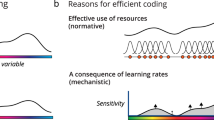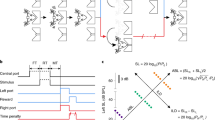Abstract
ANIMALS solve a discrimination problem more rapidly when two cues are present and relevant than when either cue is present on its own. Thus Eninger1 found that rats learned to take the correct turn in a maze faster when the correct turn was signalled by both a visual and an auditory cue than when it was signalled by one without the other. Warren2 found that monkeys learned to discriminate faster between objects differing in size and form than between objects differing in size or form alone. This phenomenon has been named ‘additivity of cues’ and has usually been interpreted to mean that individual animals solve problems containing two cues by learning to attach the correct responses to both: if animals learn to make the response as fast to each cue when they are presented together as they do to a single cue presented on its own, their discrimination performance will improve more rapidly when both cues are present than when one alone is present3.
This is a preview of subscription content, access via your institution
Access options
Subscribe to this journal
Receive 51 print issues and online access
$199.00 per year
only $3.90 per issue
Buy this article
- Purchase on Springer Link
- Instant access to full article PDF
Prices may be subject to local taxes which are calculated during checkout
Similar content being viewed by others
References
Eninger, M. U., J. Comp. Physiol. Psychol., 45, 511 (1952).
Warren, J. M., J. Comp. Physiol. Psychol., 46, 484 (1953).
Restle, F., Psychol. Rev., 62, 11 (1955).
Described in Mackintosh, N. J., Brit. J. Psychol., 54, 127 (1963).
Sutherland, N. S., in Proc. Symp. Mechanization of Thought Processes, 2, 575 (H.M.S.O., 1959).
Mackintosh, N. J., J. Comp. Physiol. Psychol., 55, 555 (1962); Brit. J. Psychol., 54, 127 (1963); J. Comp. Physiol. Psychol., 56, 842 (1963).
Author information
Authors and Affiliations
Rights and permissions
About this article
Cite this article
SUTHERLAND, N., MACKINTOSH, J. Discrimination Learning : Non-additivity of Cues. Nature 201, 528–530 (1964). https://doi.org/10.1038/201528b0
Issue Date:
DOI: https://doi.org/10.1038/201528b0
This article is cited by
-
Evidence for a Positive Relationship between Degree of Control acquired by Two Dimensions of a Complex Stimulus
Nature (1969)
-
Zur Physiologie des Formensehens bei der Honigbiene
Zeitschrift für Vergleichende Physiologie (1966)
Comments
By submitting a comment you agree to abide by our Terms and Community Guidelines. If you find something abusive or that does not comply with our terms or guidelines please flag it as inappropriate.



